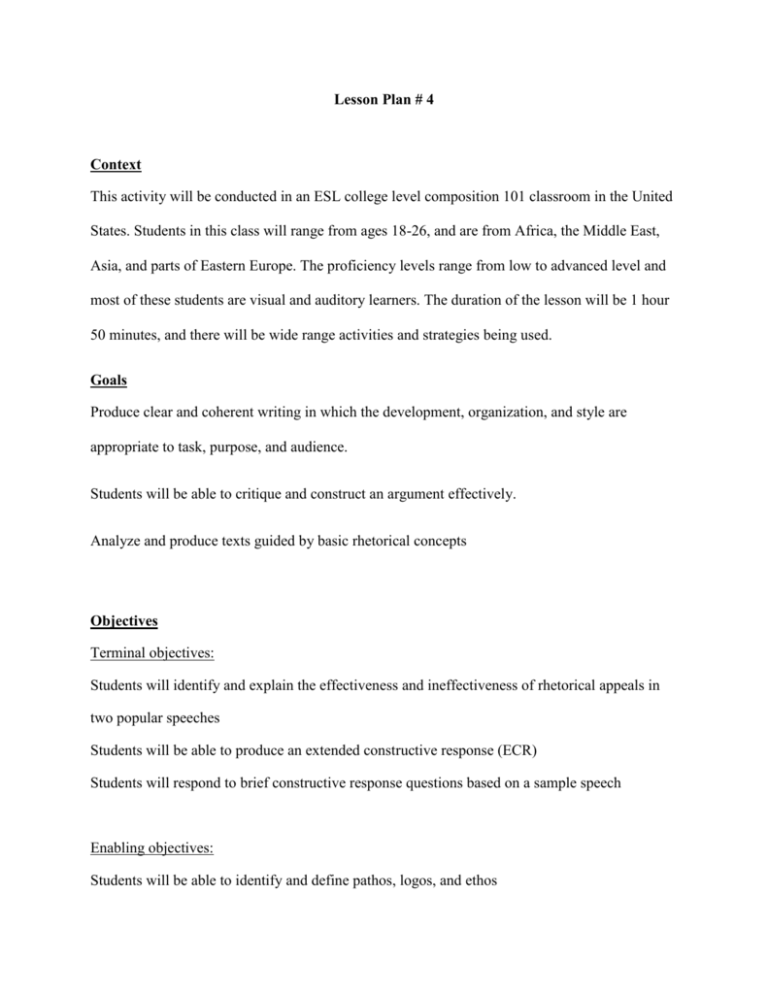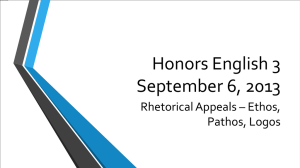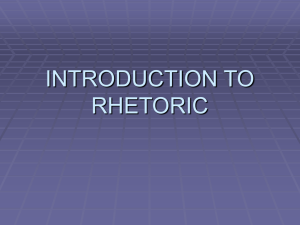Artifact 3b - WordPress.com
advertisement

Lesson Plan # 4 Context This activity will be conducted in an ESL college level composition 101 classroom in the United States. Students in this class will range from ages 18-26, and are from Africa, the Middle East, Asia, and parts of Eastern Europe. The proficiency levels range from low to advanced level and most of these students are visual and auditory learners. The duration of the lesson will be 1 hour 50 minutes, and there will be wide range activities and strategies being used. Goals Produce clear and coherent writing in which the development, organization, and style are appropriate to task, purpose, and audience. Students will be able to critique and construct an argument effectively. Analyze and produce texts guided by basic rhetorical concepts Objectives Terminal objectives: Students will identify and explain the effectiveness and ineffectiveness of rhetorical appeals in two popular speeches Students will be able to produce an extended constructive response (ECR) Students will respond to brief constructive response questions based on a sample speech Enabling objectives: Students will be able to identify and define pathos, logos, and ethos Students will explore President Franklin Delano Roosevelt’s speech in order to identify possible rhetorical appeals used Students will explain why the rhetorical appeals used in Franklin Delano Roosevelt’s speech can be justified Students will listen to Roosevelt’s December 1941 speech to US Congress Students will complete a rhetorical appeals graphic organizer in order to complete writing prompt Materials and Equipment YouTube speech Graphic organizer PowerPoint lecture slides on rhetorical appeals A copy of actual speech Graphic organizer 2 Electronic free-write space on D2l Procedures Warmup 8:00-8:10am Free write Prompt-“Has someone ever convinced you to take their stance on a certain topic/position?” If yes, explain how their rhetoric made you side with them. Students will respond to this prompt on their D2L free write space. When students have completed their responses. Teacher will ask for 4-5 volunteers to share their experiences with the rest of the class. Whole class Discussion 8:10-8:25 Teacher asks anyone in class to share their responses to the prompt, and as students share their responses, the teacher will gently lead the class to Aristotle’s rhetorical appeals. Introductory activity Teacher will briefly explain the importance of using Aristotle’s appeals in any form of persuasion Teacher will explain the objectives and justify the use of each example on her slides. Teacher will then define each appeal, and provide an example of each. Teacher will then ask students to add more examples as she proceeds in instructing her students. (See PowerPoint slide) Teacher will review Aristotle’s rhetorical appeals with class. Teacher will explain the importance of using rhetorical appeals to convince an audience. Pre-writing activity 8:25-8:40am Teacher will provide the class with an example of Logos being used in a paragraph. The teacher will ask the students to convince an audience of college students to write a paragraph that utilizes only logos. This is the example that the teacher will model to her students. After they’ve seen logos being used, they will then get in groups and use ethos or pathos to convince the same audience to attend Lalo University. Students eventually do get in groups of 4s to produce their paragraphs based on ethos or pathos. Schemata-building (Prior-knowledge) discussion 8:40-8:55am Has anyone ever watched a presidential campaign speech? If yes, what appeals do you think are Usually utilized in such speeches? Teacher will then give a couple of examples when rhetorical appeals have been used in our society. Teacher will provide examples of Obama speeches, and explain why his speeches contributed to some of his victory. Listening Activity 1 8:55-9:10 Teacher will allow the students to listen to Obama’s speech against Hilary, as students listen they will fill out this graphic organizer Evidence of Appeals in Obama speech against Hilary Pathos Logos Ethos Explain how appeal was Explain how appeal was Explain how appeal was effective/ineffective Effective/ineffective Effective/ineffective Teacher will then ask the students to identify instances of all three rhetorical appeals in the speech. Teacher will ask the students if they remember some of the factors that led the US into WW2. Whole class-discussion activity 2 9:10-9:25am Teacher will ask students to say what they remember about US policy of isolation during WW2 and what led the US into WW2 against Japan and Germany. Some students will probably give historical facts like the bombing of Hiroshima, the attack on Pearl Harbor, and US entrance into WW2. Teacher will also ask students if they remember the US President who led the US out of isolationism, and into the war. Teacher will also inform students of the presence of all three rhetorical appeals in the speech, and will ask students to carefully identify each as they listen to the speech on you tube. Major Listening Activity Upon completion of the listening component of the speech, each student will be given a tangible copy of the same speech, and the teacher will ask them to complete a second graphic organizer that identifies and justifies the effectiveness of each appeal that was used. Teacher will then hand out the hard copies of Roosevelt’s speech and will ask each student to complete the content questions. Group Reading/Jigsaw reading activity 9:25-9:40 Teacher will split the class into groups of 4s; each student in each group will be assigned a portion of the speech. When the speech has been explored in its entirety, each student will be responsible for teaching their own little component to each of their group-peers. Students will read the speech independently (if time allows)and students will be assessed on the following content questions: 1. Why is President Roosevelt trying to persuade Congress? 2. What are some of his reasons for suggesting that the US attack Japan? 3. Identify two appeals that were used by President Roosevelt, and explain how both appeals were effective in convincing congress. 4. Which appeal was ineffectively used? Explain your answer Teacher will lead the class to orally respond to each question Teacher will assess the students’ comprehension of the text and speech, and every misunderstanding will be clarified at this point. HOMEWORK Writing Task and Assessment based on Speech/Homework 9:40-9:50am At 9:40 the teacher will the students’ attention towards their writing task which will be performed at homework Teacher will constantly assess the class through each activity, as she paces the room and listens to classroom discussions What appeals did you identify in President Roosevelt’s speech? Explain the effectiveness of these appeals in convincing congress to launch out against Japan. Teacher will explain the writing prompt by reminding to focus on the use and effectiveness of Logos, ethos and pathos. Teacher will also provide an assessment tool (Checklist) to help guide students as they respond to this prompt Extra-class or homework Students will look for a print ad in a magazine or a video ad on google, and then try to identify the rhetorical appeals that are being depicted in the ad. They will culminate their activity by explaining if the appeals used rendered their ads effective or ineffective. They will also be required to see if another appeal could render the ad more captivating to a millennial audience. Critical pedagogical Connection The pedagogy of possibility is prevalent in this lesson, and has a great capacity to empower students beyond the four walls of the classroom. Students have an opportunity to explore these appeals as they learn how to make connections from the text to actual world scenarios. I would use this lesson to empower my students and promoted rhetoric that goes beyond the rhetorical appeals being seen in Roosevelt’s speech. Think for a second, one man President Roosevelt convinced an entire nation to go to war against the almighty Japanese Empire. Not only did his rhetoric convince his nation, but it also empowered them and inspired them to defeat two of the greatest belligerent rulers in the entire world. I would encourage them to compose and write speeches that use pathos, logos, and ethos to change the environment around them, and subsequently the world at large. It does not just suffice that these students identify these appeals, but they can also use them to make great textto-world connections that can empower them to initiate great changes through rhetoric. The second pedagogy of importance is that of practicality, although we have learned so many teaching theories, such as Communicative Language Teaching and the Natural Approach, I’ve had to craft my particular theory out of the many theories that I’ve been exposed to. My department requires that I teach the rhetorical appeals in some kind of persuasive genre, but in order to find my niche in this lesson I had to alter a few theories and made some modifications in order to complete this lesson. Although the CLT requires that the teacher does act as a facilitator, I still maintain some sort of teacher-control by being the main resource in the classroom.







